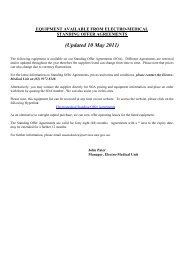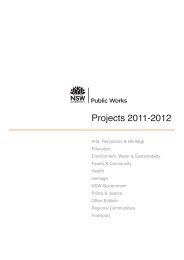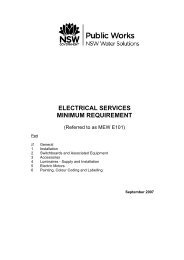Download MEW E101 April 2013 (pdf, 280kb) - NSW Public Works
Download MEW E101 April 2013 (pdf, 280kb) - NSW Public Works
Download MEW E101 April 2013 (pdf, 280kb) - NSW Public Works
You also want an ePaper? Increase the reach of your titles
YUMPU automatically turns print PDFs into web optimized ePapers that Google loves.
Part 2 - Switchboards and Associated Equipment<br />
Earth - green-yellow<br />
Cables listed in two colours (eg brown-red) shall consist of a base colour (ie brown) and<br />
a spiral trace colour (ie red). Cable trace colours shall cover between 20% and 40% of<br />
the cable surface and extend the full length of the cable.<br />
As an alternative for cables above 50mm 2 , all double insulated cables, phase<br />
identification may be 25 wide heat shrink bands of the colours tabulated above applied at<br />
each end and at not more than 500 intervals along the entire run.<br />
Identification<br />
(a) Control Wires<br />
All control wires shall be individually identified at each end. All control cables shall<br />
have the same identifying number over its entire length even when it passes in<br />
and out of a terminal block.<br />
(b) Multicore Control Cables<br />
Each cable core shall be individually identified with a number in numerals and<br />
spelt out in letters. Such identification shall be in black on to the cable cores<br />
during manufacture. Cable cores shall be consecutively numbered.<br />
(c) Plastic Cable Ferrules<br />
Cable cores which do not have integral number identification shall be identified<br />
using proprietary cable ferrules. Cable ferrules shall be flexible plastic sleeve type<br />
Z type with indelible alphanumerics. The cable ferrules shall be designed for the<br />
cable core diameter. The use of Critchley Multi-Mark and Grafoplas identification<br />
systems is acceptable.<br />
(d) Cable Sheaths Identification<br />
All cable sheaths shall be identified at both ends. Identification shall include cable<br />
number prefixed by J for instrumentation, C for control and P for power, circuit<br />
name (e.g. Pump 1) and type and size of cable (e.g. 3C + E 2.5 mm²).<br />
Identification shall be neat, permanent and legible and the following will be<br />
acceptable:<br />
- Stamped aluminium tags<br />
- Proprietary write-on tags<br />
(e) Visibility<br />
Cable and core identification shall be fully legible and visible from the front of the<br />
switchboard, control panel, equipment etc. ferrules, embossed alphanumerics,<br />
tags, etc., shall be arranged such that all letters and numerals are in line and can<br />
be readily read from the front without manipulation. Alphanumerics shall be<br />
vertically upright on horizontal cables and cores, and shall be read from the right<br />
hand side on vertical cables and cores.<br />
205.3 Large Cables (Cables above 6mm²)<br />
Not more than one cable shall terminate in a tunnel terminal, and not more than two<br />
cables shall terminate at any other connection point or terminal.<br />
Active links shall comply with paragraphs (a) to (d) of Clause 206.2.<br />
Large cables shall not be run to hinged panels or doors.<br />
In addition to the cable supports described in Clause 205.1, rigid non-metallic fixings to<br />
the switchboard cubicle shall be provided within 200 of all terminations and at not more<br />
than 400 intervals along the entire run.<br />
If the cables are in a duct, the intermediate fixings shall be within the duct.<br />
To minimise eddy current effects metal cable saddles shall not be fitted over single core<br />
cables rated over 300A.<br />
Page 40<br />
<strong>MEW</strong> <strong>E101</strong>





